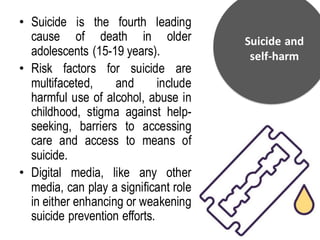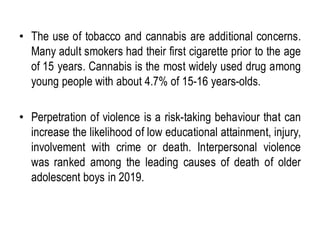Transition from Adolescence to Adulthood Mental Health and Emotional Well Being
- 1. Transition from Adolescence to Adulthood Mental Health and Emotional Well Being Dr. Vinay Kumar Gupta Uttar Pradesh University of Medical Sciences, Saifai, Etawah
- 2. Adolescence is a stage of life characterized by changes in young people’s physical, cognitive, and social and emotional development.
- 3. Adolescence as a life stage was first recognized in the 20th century, and is now understood by the WHO and many countries as the ages between 10 and 19.
- 4. • Globally, one in seven 10-19-year-olds experiences a mental disorder, accounting for 13% of the global burden of disease in this age group. • Depression, anxiety and behavioural disorders are among the leading causes of illness and disability among adolescents. • Suicide is the fourth leading cause of death among 15-29 year-olds. Key Notes
- 5. Adolescenceis a unique and formative time. INTRODUCTION
- 6. • Physical, emotional and social changes, including exposure to poverty, abuse, or violence, can make adolescents vulnerable to mental health problems. • Protecting adolescents from adversity, promoting socio- emotional learning and psychological well-being, and ensuring access to mental health care are critical for their health and well-being during adolescence and adulthood.
- 7. • Globally, it is estimated that 1 in 7 (14%) 10-19 year-olds experience mental health conditions, yet these remain largely unrecognized and untreated. • Adolescents with mental health conditions are particularly vulnerable to social exclusion, discrimination, stigma (affecting readiness to seek help), educational difficulties, risk-taking behaviours, physical ill-health and human rights violations.
- 8. Mental health determinants Adolescence is a crucial period for developing social and emotional habits important for mental well-being.
- 9. • These include adopting healthy sleep patterns; exercising regularly; developing coping, problem-solving, and interpersonal skills; and learning to manage emotions. Protective and supportive environments in the family, at school and in the wider community are important. • Multiple factors affect mental health. The more risk factors adolescents are exposed to, the greater the potential impact on their mental health.
- 10. Emotional disorders are common among adolescents Anxiety Depression Suicide Emotional disorders
- 11. • Anxiety disorders (which may involve panic or excessive worry) are the most prevalent in this age group and are more common among older than among younger adolescents. • It is estimated that 3.6% of 10-14 year-olds and 4.6% of 15- 19 year-olds experience an anxiety disorder. • Depression is estimated to occur among 1.1% of adolescents aged 10-14 years, and 2.8% of 15-19-year- olds.
- 12. • Depression and anxiety share some of the same symptoms, including rapid and unexpected changes in mood. • Anxiety and depressive disorders can profoundly affect school attendance and schoolwork. Social withdrawal can exacerbate isolation and loneliness. Depression can lead to suicide.
- 13. Behavioural disorders Behavioural disorders are more common among younger adolescents than older adolescents
- 14. • Attention deficit hyperactivity disorder (ADHD), characterized by difficulty paying attention, excessive activity and acting without regard to consequences, occurs among 3.1% of 10-14 year-olds and 2.4% of 15-19 year- olds. • Conduct disorder (involving symptoms of destructive or challenging behaviour) occurs among 3.6% of 10-14 year- olds and 2.4% of 15-19 year-olds. • Behavioural disorders can affect adolescents’ education and conduct disorder may result in criminal behaviour.
- 15. Eating disorders Eating disorders, such as anorexia nervosa and bulimia nervosa, commonly emerge during adolescence and young adulthood.
- 16. • Eating disorders involve abnormal eating behaviour and preoccupation with food, accompanied in most instances by concerns about body weight and shape. • Anorexia nervosa can lead to premature death, often due to medical complications or suicide, and has higher mortality than any other mental disorder.
- 17. Psychosis disorders Conditions that include symptoms of psychosis most commonly emerge in late adolescence or early adulthood. Symptoms can include hallucinations or delusions.
- 18. • Suicide is the fourth leading cause of death in older adolescents (15-19 years). • Risk factors for suicide are multifaceted, and include harmful use of alcohol, abuse in childhood, stigma against help- seeking, barriers to accessing care and access to means of suicide. • Digital media, like any other media, can play a significant role in either enhancing or weakening suicide prevention efforts. Suicide and self-harm
- 19. Risk-taking behaviours A wide range of early risk and protective factors influence mental health outcomes
- 20. • Many risk-taking behaviours for health, such as substance use or sexual risk-taking, start during adolescence. Risk- taking behaviours can be an unhelpful strategy to cope with emotional difficulties and can severely impact an adolescent’s mental and physical well-being. • Worldwide, the prevalence of heavy episodic drinking among adolescents aged 1519 years was 13.6%, with males most at risk.
- 21. • The use of tobacco and cannabis are additional concerns. Many adult smokers had their first cigarette prior to the age of 15 years. Cannabis is the most widely used drug among young people with about 4.7% of 15-16 years-olds. • Perpetration of violence is a risk-taking behaviour that can increase the likelihood of low educational attainment, injury, involvement with crime or death. Interpersonal violence was ranked among the leading causes of death of older adolescent boys in 2019.
- 22. Promotion and prevention Mental health promotion and prevention interventions aim to strengthen an individual's capacity to regulate emotions.
- 23. • Enhance alternatives to risk-taking behaviours, build resilience for managing difficult situations and adversity, and promote supportive social environments and social networks. • These programmes require a multi-level approach with varied delivery platforms – for example, digital media, health or social care settings, schools or the community – and varied strategies to reach adolescents, particularly the most vulnerable.
- 24. Early detection and treatment Mental health includes our emotional, psychological, and social well-being. It affects how we think, feel, and act.
- 25. • It also helps determine how we handle stress, relate to others, and make choices. Mental health is important at every stage of life, from childhood and adolescence through adulthood. • Over the course of your life, if you experience mental health problems, your thinking, mood, and behaviour could be affected.
- 26. Experiencing one or more of the following feelings or behaviours can be an early warning sign of a problem: • Eating or sleeping too much or too little • Having low or no energy • Feeling helpless or hopeless • Smoking, drinking, or using drugs more than usual • Feeling unusually confused, forgetful, on edge, angry, upset, worried, or scared • Yelling or fighting with family and friends • Having persistent thoughts and memories you can't get out of your head • Thinking of harming yourself or others
- 27. There are many ways to improve or maintain good mental health.
- 28. • Be aware of your emotions and reactions. Notice what in your life makes you sad, frustrated, or angry. Try to address or change those things. • Express your feelings in appropriate ways. Let people close to you know when something is bothering you. Keeping feelings of sadness or anger inside adds to stress. It can cause problems in your relationships and at work or school. • Think before you act. Give yourself time to think and be calm before you say or do something you might regret.
- 29. • Manage stress. Learn relaxation methods to cope with stress. These could include deep breathing, meditation, and exercise. • Strive for balance. Find a healthy balance between study and play, and between activity and rest. Make time for things you enjoy. Focus on positive things in your life. • Take care of your physical health. Exercise regularly, eat healthy meals, and get enough sleep. Don’t abuse drugs or alcohol. Keep your physical health from affecting your mental health.
- 30. • Connect with others. Make a lunch date, join a group, and say hi to strangers. We need positive connections with other people. • Find purpose and meaning. Figure out what’s important to you in life, and focus on that. This could be your work, your family, volunteering, care- giving, or something else. Spend your time doing what feels meaningful to you. • Stay positive. Focus on the good things in your life. Forgive yourself for making mistakes and forgive others. Spend time with healthy, positive people.






























